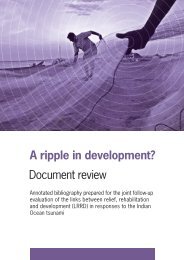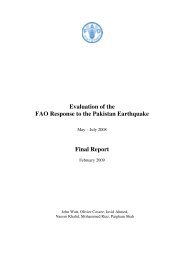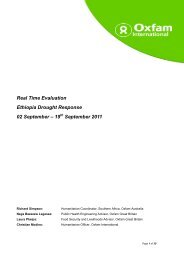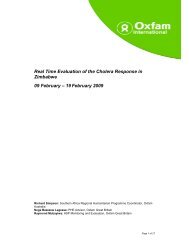Inter-Agency Real Time Evaluation of the Humanitarian ... - alnap
Inter-Agency Real Time Evaluation of the Humanitarian ... - alnap
Inter-Agency Real Time Evaluation of the Humanitarian ... - alnap
Create successful ePaper yourself
Turn your PDF publications into a flip-book with our unique Google optimized e-Paper software.
IA RTE <strong>of</strong> <strong>the</strong> humanitarian response to Pakistan’s 2010 Floods crisis<br />
from recovering due to lack <strong>of</strong> access to land, economic debts to landlords and because<br />
livelihoods could not be re‐established as quickly as in o<strong>the</strong>r affected areas.<br />
Province Deaths Injured Houses Damaged Population<br />
Affected<br />
Balochistan 54 104 75,596 700,000<br />
Khyber Pakhtunkhwa 1,156 1,198 284,990 3,800,000<br />
Punjab 110 262 497,700 6,000,000<br />
Sindh 411 1,235 876,249 7,274,250<br />
P.A.K 71 87 7,106 200,000<br />
Gilgit Baltistan 183 60 2,830 100,000<br />
Total 1,985 2,946 1,744,471 18,074,250<br />
Table 1: Pakistan: Flood looses as <strong>of</strong> 21 November 2010. Source NDMA, PDMAs and GBDMA. On 9February 2011 <strong>the</strong><br />
total number <strong>of</strong> population affected has reached 20,184,550 5<br />
7. Pakistan was not prepared for such a large‐scale disaster, probably beyond what any<br />
government can handle. It soon became clear that <strong>the</strong> Government <strong>of</strong> Pakistan (GoP) was<br />
unable to allocate sufficient resources to respond to such a monumental catastrophe.<br />
8. As a result <strong>of</strong> <strong>the</strong> floods, more than 12 million people required humanitarian assistance 6 .<br />
The geographical scale <strong>of</strong> this disaster and <strong>the</strong> number <strong>of</strong> affected people <strong>the</strong>refore makes this a<br />
larger and more complex situation than almost any o<strong>the</strong>r faced by <strong>the</strong> humanitarian community.<br />
9. Nationwide <strong>the</strong> floods washed out years’ achievements through developmental efforts.<br />
The impact <strong>of</strong> floods has worsened chronic poverty and inequality, especially among <strong>the</strong> most<br />
vulnerable parts <strong>of</strong> <strong>the</strong> Pakistani population. Affected regions such as KPK and Punjab are<br />
traditionally wealthier than Sindh, despite <strong>the</strong> latter’s wealth in agriculture and incipient<br />
tourism. Some <strong>of</strong> <strong>the</strong> main reasons behind <strong>the</strong> already existing poverty levels and inequalities<br />
are <strong>of</strong> a structural character mainly related to restricted access to land and social services.<br />
According to <strong>the</strong> World Bank, about 2 percent <strong>of</strong> Pakistani households control more than 45<br />
5<br />
For NDMA updates on damages and loses consult http://www.pakistanfloods.pk/daily‐updates/situation‐report<br />
6<br />
USAID, DCHA, OFDA Pakistan Floods Fact Sheet #7, Fiscal Year 2011 November 30, 2010.<br />
http://www.usaid.gov/our_work/humanitarian_assistance/disaster_assistance/countries/pakistan/template/fs_sr/fy<br />
2011/pakistan_fl_fs07_11‐30‐2010.pdf<br />
Riccardo Polastro, Aatika Nagrah, Nicolai Steen and Farwa Zafar<br />
20
















